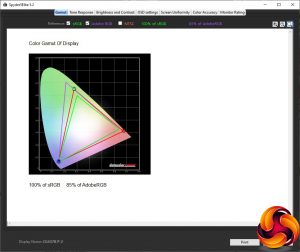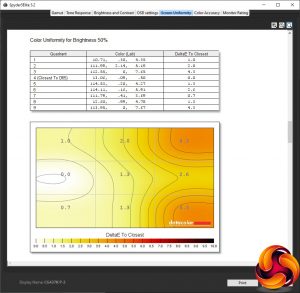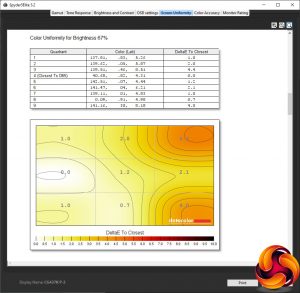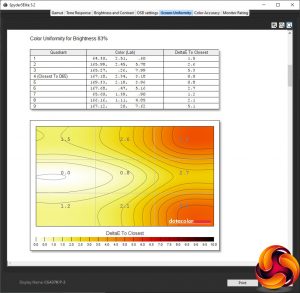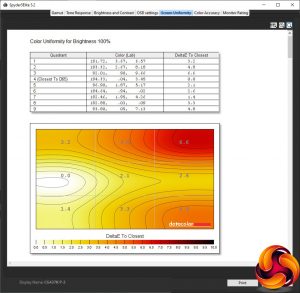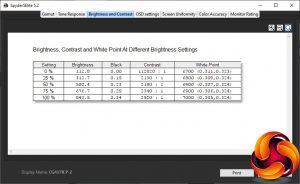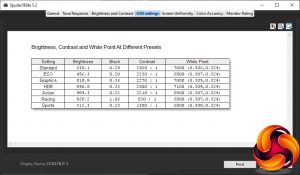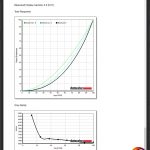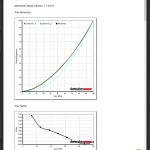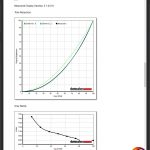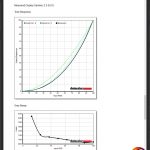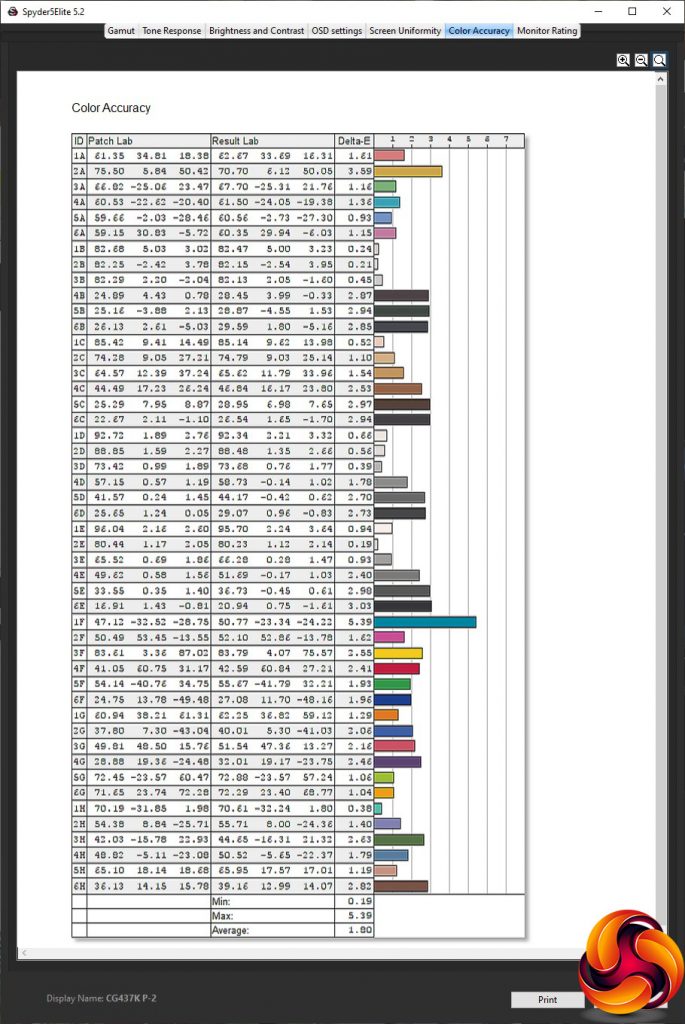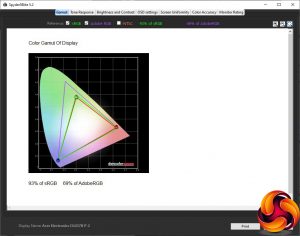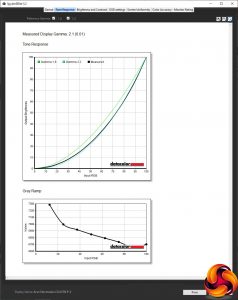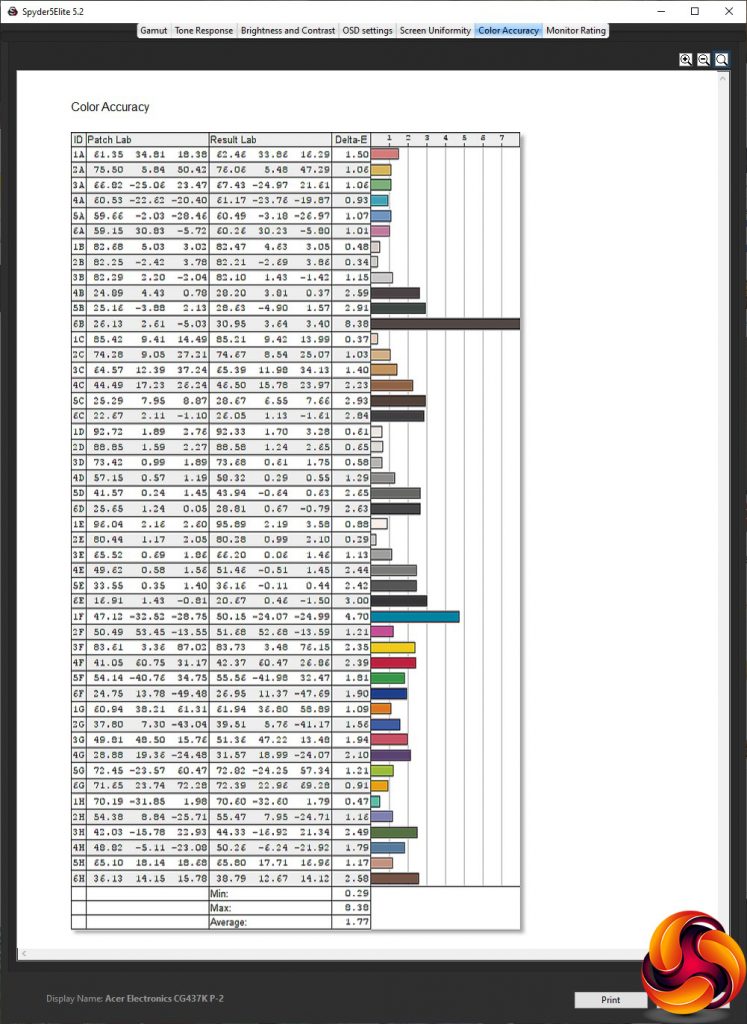Our main test involves using a DataColor Spyder Elite 5 Colorimeter to assess a display’s image quality. The device sits on top of the screen while the software generates colour tones and patterns, which it compares against predetermined values to work out how accurate the screen is.
The results show –
- A monitor’s maximum brightness in candelas or cd/m2 at various levels set in the OSD.
- A monitor’s contrast ratio at various brightness levels in the OSD.
- The brightness deviation across the panel.
- The black and white points.
- The colour accuracy, expressed as a Delta E ratio, with a result under 3 being fine for normal use, and under 2 being great for colour-accurate design work.
- The exact gamma levels, with a comparison against preset settings in the OSD.
We first run this test with the display in its default, out-of-the-box state, with all settings on default. We then calibrate the screen using the Spyder software and run the test again.
We always test the display subjectively on the Windows desktop, using it for general tasks such as browsing and word processing, and with games as well, even if the display is not intended solely for that purpose.
We pay careful attention to any artefacts, ghosting or motion blur, and enable any gaming-specific features, such as adaptive-sync settings like G-Sync or FreeSync, using a compatible graphics card in our test PC.
We performed the quality tests on the Acer Predator CG437K at its native 3,840 x 2,160 resolution in the default mode, after resetting the OSD, which sets the refresh to 60Hz. Our test system was equipped with an AMD Radeon Vega Frontier Edition graphics card, which supports FreeSync.
The gamut gets things off to a good start, with 100 per cent sRGB and 85 per cent AdobeRGB.
Brightness uniformity, however, is not so impressive, with percentage differences into double figures in a number of areas. This is perhaps not so surprising with a panel this huge, across which it will be hard to keep a supremely uniform backlighting.
Colour uniformity has similar deficiencies.
The CG437K is undeniably the brightest monitor we have ever tested, hitting 843.5cd/m2 at its highest level. The contrast is also pretty amazing, reaching 2,520:1 at 100 per cent brightness. The white point does vary a little from 6700K at zero brightness to 7000K at 100 per cent. It's also worth pointing out that this monitor never really gets that dark, returning 112.8cd/m2 even with the brightness turned all the way down.
You get a decent range of preset Modes, but they are all very bright. The Standard mode offers 635.1cd/m2 and a 2,560:1 contrast, with a fairly standard 7000K white point. Even ECO mode has a 456.3cd/m2 brightness – beyond most monitors at their brightest – and 2,230:1 contrast, with 6,900K white point. Graphics mode pumps the brightness up to 818.9cd/m2, with a similar 2,270:1 contrast and 7000K white point. HDR is the brightest mode at 840.8cd/m2, with the highest 2,550:1 contrast but a similar 7100K white point.
The gaming modes are much less bright. Action uses 494.3cd/m2, with 2,210:1 contrast and 6900K white point, whilst Racing uses the same white point but is brighter at 568.2cd/m2. Contrast is much less at 530:1. Sports mode also uses a relatively low 1,380:1 contrast, and the lowest brightness of all the presets at 312.3cd/m2, but a similar 6800K white point. Surprisingly, there's no mode for RTS or MOBA titles.
There is a fine range of gamma options, and they are mostly sequential. From 1.8 to 2.4, the true value is just one notch below the label – so the range is from 1.7 to 2.3. Strangely, 2.6 equates to 2.4. But at least you get plenty to play with.
Since this is a pricey panel, we were expecting great things when it came to colour accuracy. The average deviation of 1.8 is very good, although perhaps not quite as outstanding as we had hoped. So, as usual, we tried to calibrate the screen for even better performance.
Strangely, the gamut was negatively affected by calibration, providing a less impressive 93 per cent of sRGB and just 69 per cent of AdobeRGB.
We only retested the 2.2 gamma preset, and that remained the same at 2.1.
We were gobsmacked by how much better colour accuracy calibration had given us – a whole 0.03 improvement. Or rather we weren't. The new figure of 1.77 isn't worth the effort, and certainly not worth the reduction in gamut. So our advice – don't bother calibrating this monitor.
Overall, these are decent but not outstanding results. You won't be disappointed by the image quality this monitor can provide, but we've also seen better.
For subjective testing, we ensured FreeSync was enabled (it is by default) and attached two DisplayPort leads so we could enable 144Hz mode.
We then fired up our usual selection of comparison titles including CS:GO, Rainbow 6 Siege and League of Legends. We enabled the Action Gaming Mode preset for all three games. The frame rates were smooth, and particularly with CS:GO, FreeSync and the high refresh were doing their bit to prevent tearing or other artefacts from a lack of synchronisation between screen refresh and graphics frame delivery. However, you will need a very meaty graphics card to drive even these older titles at frame rates that tend towards 144 per second in 4K. We were only getting close with CS:GO and League from our Radeon Frontier Edition.
It's also worth noting that the built-in speakers are pretty loud and have a reasonable bass response. If you do want to use this as a TV for watching from a distance, they're more than adequate.
Be sure to check out our sponsors store EKWB here
 KitGuru KitGuru.net – Tech News | Hardware News | Hardware Reviews | IOS | Mobile | Gaming | Graphics Cards
KitGuru KitGuru.net – Tech News | Hardware News | Hardware Reviews | IOS | Mobile | Gaming | Graphics Cards




